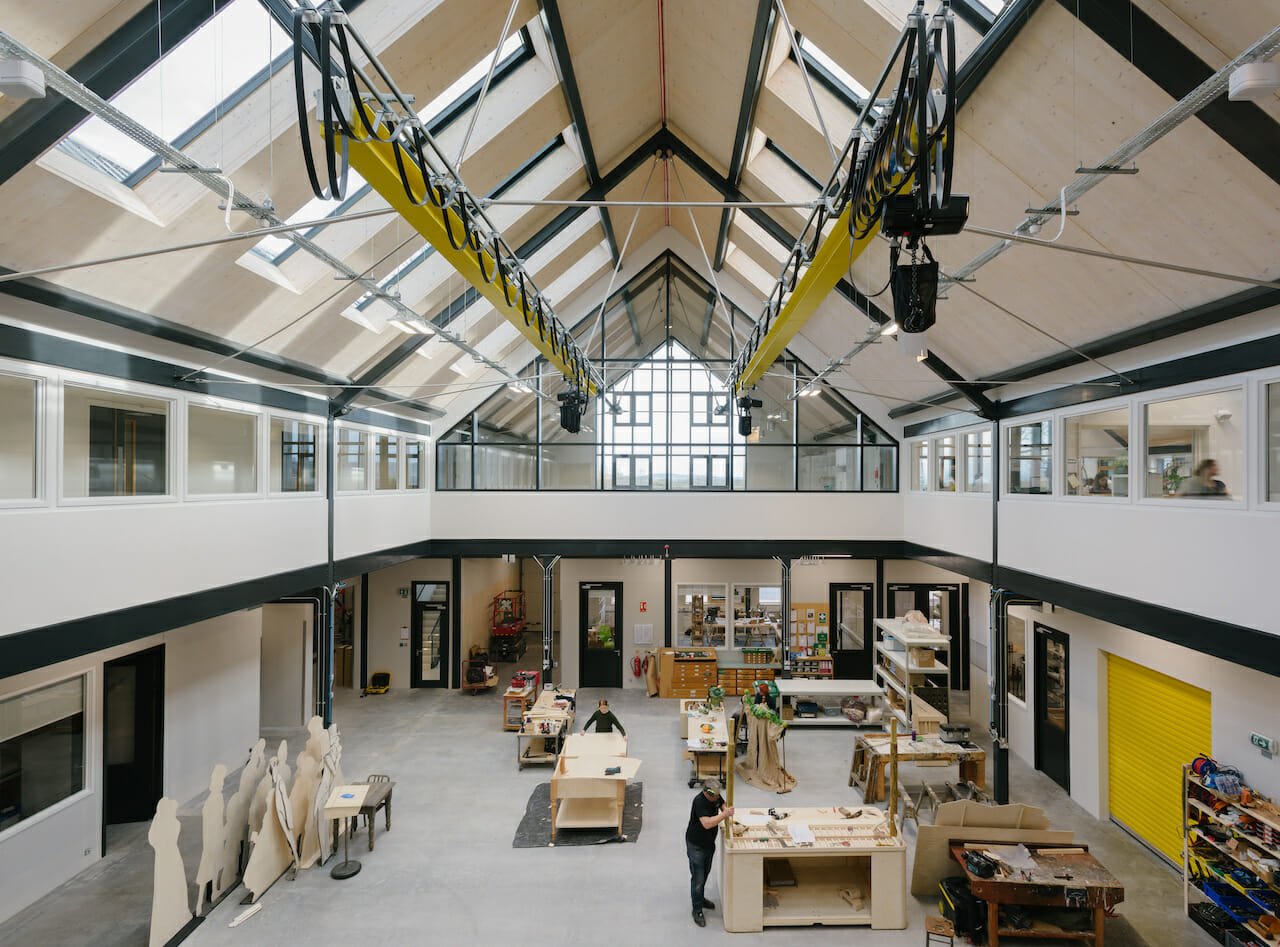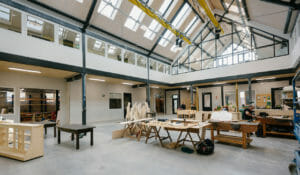
Lifting Equipment Store (LES) supplied four 500kg capacity D8+ GIS electric chain hoists for installation on two identical beams installed in a new production workshop facility in Lewes, East Sussex, UK.
The so-called Production Hub is conveniently located near the stage door of Glyndebourne’s 1,200-seat opera house. In order to continue to meet demand for elaborate scenery and props, and to take more performance-related construction work in-house, the venue invested millions of pounds in a new building—with the hoists centre stage.
The building was constructed on similar principles to a traditional Sussex barn. A steel frame was erected on a concrete slab to provide the internal and external load-bearing structure. The heart of the building is a central area for assembling large props and scenery. It is two storeys high (approx. 12m to the ridge of the roof) and approx. 11m wide by 17m long, with a margin all round overhung by the first floor. Above are the two beams, spanning approx. 10m.
Paul Brown, head of props at Glyndebourne, said: “On a recent build we were making giant puppets and the hoists were in use every day. The puppets were permanently hung from the beams while we were working on them, lowered in by the hoists to be worked on and then taken back up again. In the old workshop, when we used to have large pieces like that to work on, we’d have lifted them manually with a block and tackle. It would have been a rope through a pulley and two or three people pulling on the other end, which is far from ideal. That’s why one of the things we specified for the Production Hub was to get some hoists in so we could lift safely—it was one of the first things down on the piece of paper.”
The assembly area gives access to a series of enclosed workshops which provide facilities for working in wood, metal, plastics, fabric and paint—all equipped as necessary with tools, plus dust and fume extraction. Notably, the columns holding up the first floor are inset from the corners to facilitate manoeuvrability of larger pieces. The design team was appointed in January 2017; work commenced 12 months later. It was completed earlier this year—on time and on budget.
Lift Turn Move Ltd. (LTM; LES’s go-to provider of specialist lifting solutions for entertainment and cleanroom installations) delivered the LP500 hoists, manufactured in Switzerland. The biggest challenge was in that the hoists were only sourced once the beams were installed in the completed building.
Symon Horton, sales manager at LES, said: “The brief we received was for four single-speed chain hoists, mounted on a single-speed trolley, with chain falls of approx. 9-10m. They didn’t want trailing cable and preferred not to operate the equipment with pendant controls. Moreover, they wanted us to arrange delivery and installation to the tight time schedule that was in place; we noted that the £6m-plus project was powered by fund raising endeavours.”
Stuart Fraser, head of entertainment products at LTM, said: “As this is a workshop but on a theatre site, we proposed an entertainment hoist, and always typically do. There are occasions where workshop technicians might walk close to or even under the load, so a hoist to D8+ [applicable standard] is ideal for the static suspension of the application—and a safe working environment.”
He added: “We do a lot of work with permanent installations in venues and stage engineering applications. Chain hoists have always been an integral part of most theatre installations, due to the robustness, ease of installation, and the ability to move them to a different location, if required.”
Fraser said that the control option chosen was a Guardian four-channel, wall-mounted system complete with remote handset, enabling operation of all four hoists from one location. “Operation is with a simple toggle switch hoist directional selection, and then a push to run the hoist,” he said. “This is an extremely good value multi-hoist control system for this purpose, and is installed in venues in multiple countries. The hoists can be used in conjunction with each other to lift larger items.”
Brown added: “The hoists have been really useful to us. They’ve made things safer because we’re no longer doing manual lifts; we’re able to use the hoists to lift in a much more controlled way. We’re lifting irregular loads—really unusual pieces sometimes—so the flexibility of having four hoists allows us to look at different combinations of lifts. We recently lifted an engine out of a car; we were able to lift the whole engine out and onto a pallet. That’s something we wouldn’t have been able to do in-house before.”
Installation of the hoists, festoon system and control panel was completed by BJ Designs, an independent engineering design and project management company.
Glyndebourne delivers performances to 150,000 people across a summer festival and an autumn tour. The hoists are an important part of the back-stage process for every show.



